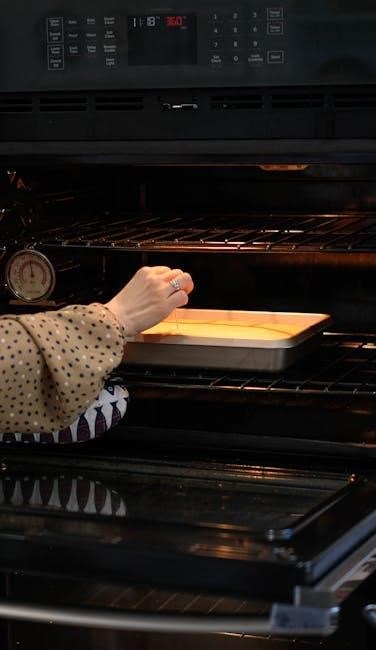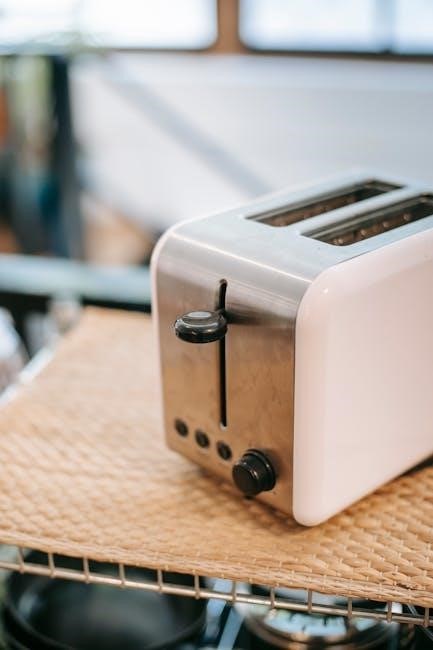
bosch oven manual
Your Bosch oven manual is a comprehensive guide designed to help you understand and utilize your appliance effectively. It covers installation, safety, operation, and troubleshooting to ensure optimal performance and longevity of your oven. By following the manual, you can explore advanced features, maintain your oven, and resolve common issues efficiently. This resource is essential for both new and experienced users to make the most of their Bosch oven.
1.1 Overview of Bosch Oven Manuals
Bosch oven manuals provide essential information for optimal appliance usage, including installation, operation, and maintenance. They detail safety guidelines, troubleshooting tips, and feature explanations. Manuals are available online, accessible by entering the appliance’s model number (E-Nr). They cover topics like energy efficiency, cooking modes, and error codes. These guides also offer advice on cleaning, care, and resolving common issues. By referencing your Bosch oven manual, you can ensure safe and efficient use, unlocking your oven’s full potential while maintaining its performance and longevity. Regularly consulting the manual helps users make the most of their appliance’s advanced features and eco-friendly settings.
1.2 Importance of Reading the Manual
Reading your Bosch oven manual is crucial for safe and effective appliance operation. It provides vital instructions on installation, usage, and troubleshooting, ensuring you understand all features and functions. The manual highlights safety precautions, such as not connecting a damaged appliance and proper usage guidelines. It also offers maintenance tips to preserve performance and longevity. By following the manual, you can avoid common mistakes, resolve issues quickly, and optimize your cooking experience. Additionally, it helps you understand energy-saving modes and advanced features, enabling you to make the most of your Bosch oven while adhering to safety and efficiency standards.

How to Find Your Bosch Oven Manual
To find your Bosch oven manual, visit the official Bosch website and search using your oven’s model number (E-Nr). Manuals are available online in multiple languages.
2.1 Locating the Model Number (E-Nr)
To locate the model number (E-Nr) of your Bosch oven, check the rating plate, usually found on the oven door frame or side panel. The E-Nr is an alphanumeric code starting with “E” followed by numbers. It may also be printed on the back of the oven or in the user manual. Once identified, visit the Bosch website, navigate to the support section, and enter the E-Nr to download your specific manual. Ensure accuracy to match your oven model for correct instructions. If unsure, refer to the serial number label or packaging for confirmation.
2.2 Downloading the Manual from the Bosch Website
Visit the official Bosch website and navigate to the “Support” or “Customer Service” section. Click on “Product Manuals” or “Downloads” and select “Oven” from the product category list. Enter the model number (E-Nr) located on your oven’s rating plate. Choose your language and click “Search.” Once the manual appears, select the download option to save it as a PDF. Ensure your device has a PDF reader installed to open the file. If the manual isn’t found, double-check the model number or contact Bosch customer support for assistance. This ensures you have the correct guide for your specific oven model.

Safety Precautions
Always keep children away from the oven, use oven mitts, and avoid flammable materials nearby. Never leave cooking unattended and ensure proper ventilation to prevent accidents and hazards.
3.1 General Safety Guidelines
Always follow Bosch oven manual instructions to ensure safe operation. Ensure the oven is installed on a stable, heat-resistant surface. Avoid overloading racks and use oven mitts to handle hot dishes. Keep children away from the oven while it’s in use, and never leave cooking unattended. Ensure proper ventilation to prevent carbon monoxide buildup. Avoid wearing loose clothing near the oven to reduce fire risks. Regularly inspect power cords and connections for damage. Never use the oven if it’s damaged or malfunctioning. Follow recommended cooking times and temperatures to prevent overheating. Always turn off the oven when not in use to conserve energy and ensure safety.
3.2 Do’s and Don’ts for Oven Usage
Do ensure the oven is preheated to the correct temperature before cooking. Always use oven-safe cookware and avoid placing plastic or metal utensils inside. Keep the oven clean to prevent food residue buildup. Use the correct rack positions for optimal cooking results. Do not open the oven door unnecessarily during cooking. Avoid using abrasive cleaners or sharp objects to prevent damaging the interior. Do not place flammable materials near the oven. Never use the oven as a storage space. Always follow the recommended cooking times and temperatures. Do not ignore unusual smells or sounds, as they may indicate a malfunction. Always unplug the oven during cleaning or maintenance.

Installation and Setup
The oven must be installed by a qualified technician, ensuring proper placement and ventilation. Connect it to the correct power supply and configure initial settings like clock and language.
4.1 Installing the Oven in Your Kitchen
Installing your Bosch oven requires careful planning and professional assistance. Ensure the oven is placed in a well-ventilated area, away from flammable materials. Measure your kitchen space accurately to fit the oven properly. The installation location must be level and stable to ensure even heating. A qualified technician should handle the electrical connections, adhering to local safety standards. Always follow Bosch’s installation guidelines to avoid voiding the warranty. Proper placement and connection are crucial for safe and efficient operation. Refer to your manual for specific installation requirements tailored to your model.
4.2 Initial Setup and Configuration
After installation, perform the initial setup by reading the manual thoroughly. Ensure all electrical connections are secure and the oven is placed in a well-ventilated area. Set the clock and language preferences using the control panel. Check for any software updates via the Bosch Home Connect app, if applicable. Familiarize yourself with the oven’s sensors and automatic functions. Test basic operations, such as heating and fan settings, to ensure proper functionality. Refer to the manual for specific configuration steps tailored to your model. Proper setup ensures optimal performance, safety, and warranty validity. Always follow Bosch’s guidelines for initial configuration.
Operating Your Bosch Oven
Mastering your Bosch oven’s operation involves understanding its intuitive controls, exploring various cooking modes, and utilizing smart features for precise and efficient cooking experiences every time.
5.1 Basic Controls and Functions
Understanding the basic controls and functions of your Bosch oven is essential for seamless operation. The control panel typically features a touchscreen or knobs, depending on the model, allowing you to adjust temperature, time, and cooking modes. The display panel shows current settings, while buttons enable easy navigation through menus. Knobs often control temperature and timer functions, ensuring precise adjustments. Familiarize yourself with the Start/Stop button, which initiates or pauses cooking. The oven light button lets you monitor cooking progress without opening the door. These intuitive controls are designed for ease of use, ensuring you can achieve perfect results with minimal effort and time.
5.2 Understanding Cooking Modes and Settings
Bosch ovens offer a variety of cooking modes tailored to specific culinary needs. Common modes include Conventional, Convection, Grill, and Steam cooking, each providing unique benefits. Conventional mode uses top and bottom heating elements for traditional baking, while Convection circulates hot air for even cooking and faster results. Grill mode is ideal for browning or crisping food, and Steam mode ensures moist, healthy dishes. Additional settings like defrosting or slow cooking add versatility. Understanding these modes allows you to optimize cooking results. Adjusting settings such as temperature, timers, and fan speed further customizes your cooking experience, ensuring dishes are cooked to perfection every time.

Maintenance and Cleaning
Regular cleaning ensures optimal performance. Wipe surfaces after use and deep clean occasionally. Use compatible cleaning products to avoid damage. Routine inspections prevent wear and tear. Ensure the oven is cool before cleaning for safety.
6.1 Regular Cleaning and Care Tips
Regular cleaning is essential for maintaining your Bosch oven’s performance and hygiene. After each use, wipe down surfaces with a damp cloth to remove food residue. For tougher stains, use a gentle cleaning solution or Bosch-approved products. Avoid abrasive materials that could scratch the interior. Steam cleaning is a recommended method for deep cleaning without harsh chemicals. Always ensure the oven is cool before cleaning to prevent burns. Clean the racks and shelves in warm soapy water, and dry thoroughly before replacing. Regular care prevents grease buildup and ensures optimal cooking results. Consistent maintenance also extends the lifespan of your Bosch oven.
6.2 Maintaining Optimal Performance
To maintain your Bosch oven’s optimal performance, regularly inspect and clean the heating elements, as food residue can affect heat distribution. Check the oven door seals for wear and tear, as leaks can reduce efficiency. Ensure proper ventilation by cleaning the exhaust fan and ducts. Calibrate the temperature periodically using the manual’s guidance to ensure accuracy. Avoid overloading the oven, as this can strain the heating elements. Use oven-safe cookware to prevent damage from thermal shock. Finally, run the self-cleaning cycle periodically to remove stubborn grime. These steps ensure your Bosch oven operates efficiently and consistently delivers excellent cooking results over time.

Troubleshooting Common Issues
Troubleshooting common issues with your Bosch oven involves checking power connections, ensuring proper installation, and referencing the manual for error codes. Resetting the oven often resolves problems.
7.1 Identifying and Solving Common Problems
Common issues with Bosch ovens include error codes, uneven heating, or malfunctioning controls. Start by checking the power supply and ensuring the oven is properly installed. Refer to the manual for specific error code meanings, as they often indicate precise solutions. For uneven heating, verify that shelves are correctly positioned and that vents are unobstructed. If buttons or controls are unresponsive, restart the oven or reset it by switching off the power for 30 minutes. Cleaning sensors and descaling water systems can also resolve performance issues. Always consult the manual for model-specific troubleshooting steps before contacting customer support.
7.2 Resetting the Oven and Error Codes
Resetting your Bosch oven can resolve minor glitches. Turn the oven off, unplug it, and wait 30 minutes before plugging it back in. This resets the electronic controls. For error codes, refer to your manual, as each code (e.g., E001, E011) indicates a specific issue. Common codes relate to temperature sensors or fan motor malfunctions. If resetting doesn’t resolve the issue, contact Bosch support. Regular maintenance, like cleaning sensors, can prevent errors. Always follow the manual’s guidance for error code solutions, as improper handling may void the warranty or cause further damage. Addressing codes promptly ensures optimal oven performance.

Advanced Cooking Techniques
Explore advanced cooking methods to elevate your culinary skills. Utilize convection for even roasting, steam for moist dishes, and precision temperature control for perfect results. Smart sensors optimize cooking times and temperatures, ensuring consistency. Experiment with multi-level cooking and delayed start functions for convenience. These features enhance flavor and efficiency, making complex recipes achievable. Discover how to pair techniques for exceptional outcomes, whether baking, roasting, or slow cooking; Advanced modes empower you to create gourmet meals effortlessly.
8.1 Using Special Features Like Convection
Your Bosch oven’s convection feature enhances cooking efficiency by circulating hot air with a fan, ensuring even browning and faster cooking. To use it, locate the convection setting on the control panel, which may be labeled as “Convection” or have a fan icon. Select the desired mode, which might include options like with or without steam or different fan speeds. Refer to your manual for specific temperature and time guidelines, as convection typically requires lower temperatures and shorter cooking times compared to traditional baking. Ideal for roasted vegetables, meats, and baked goods, convection cooking can also be used for frozen foods like pizza, following manual recommendations. For optimal results, adjust rack positions and consider rotating pans for even cooking; Some models may offer a steam-convection combination, beneficial for keeping meats moist or baking bread. Always follow safety precautions, such as using appropriate cookware and keeping the oven door closed during convection to maintain airflow. Experimenting with these settings will help you maximize the benefits of convection cooking, leading to crispier and evenly cooked dishes.
8.2 Optimizing Cooking Results
To optimize cooking results with your Bosch oven, ensure proper preheating and use the correct cookware. Select the right baking sheet size to allow airflow, and arrange food evenly. For multi-rack cooking, rotate pans halfway through to ensure uniform results. Utilize the steam function for dishes like bread or roasts to enhance moisture and flavor. Adjust recipes for convection cooking by reducing temperatures and times as needed. Regularly clean the oven to prevent residue from affecting taste. Refer to your manual for specific settings and tips tailored to your model. Experiment with advanced features like slow cooking or proofing for precise control. Achieve professional-grade outcomes by mastering these techniques and exploring the full potential of your Bosch oven.

Energy Efficiency and Eco Modes
Bosch ovens feature advanced energy-saving technologies and eco modes designed to reduce power consumption while maintaining performance. These settings optimize cooking processes for lower energy use and environmental impact.
9.1 Understanding Energy-Saving Features
Bosch ovens are equipped with cutting-edge energy-saving features designed to minimize power consumption without compromising performance. Key technologies include eco modes, smart sensors, and advanced heating elements that optimize energy use. These features work by adjusting cooking cycles, reducing standby power, and utilizing residual heat effectively. Eco modes, for instance, lower the oven’s energy consumption during operation, while smart sensors monitor cooking progress to prevent overcooking. Additionally, certain models offer automatic shut-off and energy-efficient preheating. By leveraging these technologies, users can significantly reduce their energy bills and environmental impact. Always refer to your specific model’s manual for detailed information on these features.
9.2 Using Eco Modes Effectively
Eco modes on Bosch ovens are designed to enhance energy efficiency while maintaining cooking quality. To use them effectively, select the eco mode for recipes that don’t require intense heat, such as baking or gentle roasting. Preheating times may be slightly longer, but overall energy consumption is reduced. Ensure cookware is compatible with eco modes, as some materials conduct heat better. For optimal results, follow the recommended temperatures and cooking times in your manual. Regularly cleaning your oven ensures eco modes function efficiently. By utilizing eco modes, you can save energy, lower utility bills, and contribute to a more sustainable cooking routine.

Accessories and Optional Equipment
Bosch ovens can be enhanced with various accessories like multi-purpose racks, baking trays, and cleaning tools. Optional equipment such as steam baskets or smart cooking sensors can also be added.
10.1 Recommended Accessories for Your Bosch Oven
Bosch offers a range of recommended accessories designed to enhance your oven’s functionality. These include multi-functional baking trays, telescopic racks for easy food access, and heat-resistant glass panels for better visibility. Additional accessories like pizza stones, steam baskets, and roasting pans can elevate your cooking experience. These items are tailored to fit your Bosch oven perfectly, ensuring optimal performance and versatility. Visit the Bosch website or authorized dealers to explore the full range of compatible accessories. Properly using these tools can help you achieve professional-grade results while maintaining your oven’s longevity and efficiency.
10.2 Optional Equipment for Enhanced Functionality
Bosch offers optional equipment to enhance your oven’s capabilities. These include smart connectivity modules, enabling Wi-Fi control through Bosch’s Home Connect app. A food sensor is another option, automatically adjusting cooking settings for perfect results. Additional racks, such as extending telescopic racks, improve accessibility and multi-level cooking. Steam injection systems can be installed for advanced moisture control during baking. These upgrades allow for greater customization and versatility, tailored to your cooking preferences. Explore Bosch’s online shop or authorized retailers to discover the full range of optional equipment designed to complement your oven and elevate your culinary experience to new levels.

Warranty and Customer Support
Bosch ovens come with a comprehensive warranty covering parts and labor for a specified period. Register your product to activate warranty benefits and access dedicated customer support, including phone, email, and live chat assistance, along with online resources like FAQs and service locator tools.
11;1 Understanding Your Warranty Coverage
Your Bosch oven is protected by a warranty that typically covers defects in materials and workmanship for a specified period, often 1 to 2 years. This warranty applies to the oven and its original parts, providing free repairs or replacements during the coverage term. Registration may be required to activate the warranty, ensuring you receive full benefits. Damage caused by misuse, improper installation, or unauthorized repairs is usually excluded. Always review the warranty terms in your manual or on the Bosch website for precise details and conditions. Proper maintenance and adherence to guidelines can help maintain warranty validity and ensure optimal performance.
11.2 Contacting Bosch Customer Support
Bosch offers comprehensive customer support to assist with inquiries, troubleshooting, or service requests for your oven. You can reach Bosch customer support via phone, email, or live chat through their official website. Visit the Bosch website, navigate to the “Support” section, and select your country to access contact details. For faster assistance, have your oven’s model number (E-Nr) and serial number ready. Additionally, Bosch provides online resources, including FAQs and user manuals, to help resolve common issues. If visiting a local Bosch website, ensure it matches your region for accurate and relevant support. Bosch aims to provide timely and effective solutions to enhance your ownership experience.
By following your Bosch oven manual, you can ensure optimal performance, safety, and longevity. Regular maintenance, proper usage, and exploring advanced features will enhance your cooking experience.
12.1 Summary of Key Points
Your Bosch oven manual is a comprehensive guide to unlocking your appliance’s full potential. It covers installation, safety precautions, operational modes, and maintenance tips to ensure longevity. Understanding the manual helps you navigate features like cooking modes, energy efficiency, and troubleshooting. Regular cleaning and proper usage are emphasized to maintain performance. Additionally, it provides insights into advanced techniques and eco-friendly settings. Referencing the manual ensures safe and efficient operation, tailored to your specific model. By following the guidelines, you can enhance your cooking experience and extend the lifespan of your Bosch oven.
12.2 Final Tips for Getting the Most Out of Your Bosch Oven
To maximize your Bosch oven’s performance, experiment with various cooking modes and features like convection for even cooking. Regularly clean the oven to maintain efficiency and hygiene. Use recommended accessories to enhance functionality. Plan meals in advance to utilize eco modes effectively. Keep the oven updated with the latest firmware for optimal performance. Always refer to the manual for specific model features. Explore recipes tailored to your oven’s capabilities for best results. For any issues, contact Bosch customer support for assistance. By following these tips, you’ll enjoy a seamless and satisfying cooking experience with your Bosch oven.